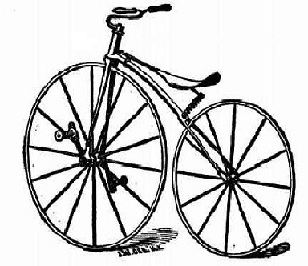Secondly, Calvert has recorded some important variations in velocipede design, thus documenting an early period of Australian bicycle development. James Finlay keenly advertised his cycles as being based on an American design, most probably Pickering’s American Velocipede. This design has a frame which was claimed to be lighter and stronger than French designs, and is characterized by a brake that is applied by the rider leaning back in their seat.5 The following illustration of a Pickering’s American Velocipede shows the similarity in design to Calvert’s depiction of “The Barb":

Pickering’s American Velocipede 18696
In comparison, Melbourne vintage cycle collector Paul Farren feels that Calvert has shown the second velocipede, ridden by Mr Warnock, to have features similar to the French Michaux design.7 Strangely, the Melbourne newspapers had earlier predicted a challenge to James Finlay by the French velocipedes:
“…he will soon have to contend against the imported French bi-cycles, a number of which are on their way to the colony.”8
Paul Farren also notes that the two tricycles to the right of the Calvert scene, are likely to be of an 1860 American design that was propelled by the action of feet as well as hands and arms (called “Rantoons”).9
The third point of interest in Calvert’s lithograph, is the two prominent men in the right foreground of the scene. The gentleman to the right with the starter’s pistol is described as “Mr Wardell” by the “Illustrated Australian News for Home Readers”.10 It is possible that this was a misspelling, as it is more likely that Mr R.W. Wardill – a member of the Athletic Sports “Committee of Organisation”11 – was the starter shown. Wardill – a Melbourne Cricket Club (M.C.C.) member – was significant in the organization of early 1860’s Athletic Sports events held on the Melbourne Cricket Ground (M.C.G.).12
If the starter was indeed Wardill, it is likely that the other gentleman in the lithograph’s foreground – the judge of the race – may have been either Mr W.J. Hammersley or Mr H.C.A Harrison – two other members of the day’s “Committee of Organisation”.13 All of these men were known to have been part of a group which “bore the financial risk involved” in the early Athletic Sports meetings at the M.C.G..14
The fourth and possibly most significant point of interest in Calvert’s lithograph relates to a small detail drawn on the facing M.C.G. building, and the subsequent widespread claim of this race being described as the first bicycle race in Victoria.
Calvert has laboriously recorded a clock face high on the facing pavilion - with the time 4.25 hazily decipherable - showing the finishing time of the race. Regardless of this being a deliberate feature or not, the scene is obviously showing daylight hours. This feature is highly significant due to the fact that a separate velocipede race was taking place at the Croxton Park racetrack, on the same day as the M.C.G. races. In fact, it was thought that several velocipede competitors who had originally nominated for the M.C.G. race actually ended up riding at Croxton Park.15
However, the Croxton Park velocipede race is recorded as finishing under the curtain of early evening darkness.16 Thus, it could be assumed that the Croxton Park race finished at a later time than the M.C.G. race. By only a few hours, the feted M.C.G. race was possibly able to claim the prestige of being “first".
In 1869, Samuel Calvert recorded his artistic details with the accuracy of the lens of a camera. His lithograph of the finishing moments of the earliest known Victorian bicycle race, at the Melbourne Cricket Ground, describes a more complex scene than words alone can capture. If only Calvert could realize how significant some of the smaller details of his lithograph would become with the passing of centuries!
© 2011-2015 This article remains the property of the website administrators.
References:
1. Thomas Darragh, “Samuel Calvert: Biography”, Design and Art Australia Online, http://daao.org.au/bio/samuel-calvert/#artist_biography
2. Ibid.
3. Ibid.
4. Illustrated Australian News for Home Readers (Melbourne, Vic: 1867-1875), August 7, 1869, 161. http://nla.gov.au/nla.news-article60450379
5. Velox, “Velocipedes, bicycles and tricycles: How to make and how to use them”, American Libraries Internet Archive, 54-56. http://www.archive.org/details/velocipedesbicy00velgoog
6. J.T. Goddard, “The velocipede: Its histories, varieties and practice”, 1869, graphic displayed on Clipart Technical. http://clipart-technical.com/Transportation-/Cycles/62-431x340.jpg.php
7. Farren P., personal communication, Sept 8, 2011.
8. The Argus (Melbourne, Vic.: 1848-1956), June 22, 1869, 5. http://nla.gov.au/nla.news-article5832508
9. See note 7 above.
10. “Velocipede race on the Melbourne Cricket Ground”, The Argus (Melbourne, Vic: 1848-1956), August 7, 1869, 164. http://nla.gov.au/nla.news-article60450417
11. The Argus (Melbourne, Vic.: 1848-1956), July 10, 1869, 8. http://nla.gov.au/nla.news-article5832779
12. Alf Batchelder, “Pedestrians and cyclists at the MCG”, 2004, Melbourne Cricket Club Library, 4 & 5.
13. See note 11 above.
14. See note 12 above.
15. The Mercury (Hobart, Tas: 1860-1954), July 17, 1869, 3. http://nla.gov.au/nla.news-article8860198
16. “Croxton-Park Steeplechases”, The Argus (Melbourne, Vic.: 1848-1956), July 12, 1869, 6. http://nla.gov.au/nla.news-article5821042